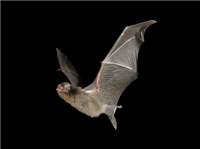Family
Vespertilionidae
Genus
Miniopterus
Species
schreibersii
Threats/Control Methods - Regional
This species is currently considered to be facing severe threatening processes. Land clearing and the loss of large trees for urban developments, agriculture and forestry lead to decreasing foraging resources. The frequent disturbance to the hibernation caves leads to serious increases in winter deaths. The species depends on the availability of just a few good maternity caves, many of which are threatened by land use changes and other disturbances, both natural and human.
Threats/Control Methods - Local
The removal of large trees from urban areas and the large number of free-roaming domestic Cats (Felis catus) are major local threats.
Local/Urban Actions
Environment ACT is currently undertaking actions to research and strategically manage local grassland sites to improve its conservation. Residents can get involved in groups such as Friends of Grasslands and Greening Australia to help improve native ecological communities.
Common name/s
Common Bent-wing Bat, Schreibers© Long-tailed Bat, Schreibers© Bat, Eastern Bent-winged Bat, Bent-winged Bat, Long-fingered Bat (in
Distinguishing Features
This furry looking bat has very dark red-black coloured fur above and lighter fur underneath. Its head and body length is about 5.5cm. The head is composed of a short snout with a large, domed forehead, small dark eyes and small round ears. Its third finger has an elongated joint four times the length of its other joints, which bends under its wing, hence its name.
Similar Species
The Little Bent-wing Bat (Minipterus australis) is smaller and has a range restricted to QLD and northern NSW.
Distribution
This species is found across the north of WA, NT and QLD, and south along the eastern areas of QLD, NSW and VIC. They are also found in part of
Country of Origin
Australia
Survey Techniques
Ultrasound and cavern searches lead to the identification of this species.
Conservation (Pet/Pest) Status - National
The Department of Environment and Water Resources considers this species as Conservation Dependant under the EPBC Act 1999, due to the small number of maternity caves that need to be kept free from human interference.
Conservation (Pet/Pest) Status - Regional
Listed as Vulnerable in the NSW Legal Status (2000).
LSCCES Population
Fairly common throughout the ACT region.
Associated vegetation community
This species inhabits forest and woodland areas with good tree cover. They roost in caves, but where these are unavailable, they will use old mines, stormwater drains or old empty buildings.
Limiting Resources
The diet and habitat needed for the survival of this species is very specific. An ample number of trees provide the foraging resources necessary for this species. The temperature and humidity of the maternity cave used by up to 60,000 nesting females must be constant, as a change of 0.1 of a degree to the inner cave temperature may make conditions unfavourable for the development of the young.
Breeding
Mating and fertilisation occurs from late May to early June, just before hibernation. The implantation from the ovary is delayed until the end of the hibernation period. At the beginning of spring, adult females move away from scattered roosts to specific maternity caves of high temperature and humidity. In December, as single naked young is born to each female. At this time, young bats are massed on the ceiling with up to 3000 fitting in a square metre. By late February, the mothers and young of the maternity colonies disperse and separate. Young individuals may move hundreds of kilometres. They can live up to 18 years of age.
Behaviour
This species roost in caves during the day and can travel up to 200km between the roost site and their maternity cave. They travel from roost to roost according to the changing seasonal availability of food, suitable roosting sites and the needs of the bats at different life stages. During the evening they fly above tree canopies feeding. During the wintertime, when insects are scarce, Bent-wing Bats hibernate, emerging in late August.
Functional Group
Food Species
The Bent-wing Bat collects flying insects like moths from above the tree canopy.
Predators
Various owls, pythons, feral cats (Felis catus ) and occasionally foxes (Vulpes vulpes ) prey upon the Bent-wing Bat.
Interesting Fact
No other hibernating bat is known to possess the capacity to delay the implantation of the sperm to the egg for months after the mating event.
References - (reader suitability of references, P=Primary teachers, S=Secondary students, T=Tertiary students and researchers)
Books:Strahan, R. (ed.) 1995. The Mammals of Australia. Australian Museum Trust/Reed Books. Chatswood NSW. P, S, T
Online Publications: Environment ACT. 2006. ACT Lowland Native Grassland Conservation Strategy.[online]. Available at: http://www.environment.act.gov.au/__data/assets/pdf_file/13039/actionplan28chapter2.pdf S, T
Lumsden, L and Platt, S. 1991. Land for Wildlife Notes: Bats in Rural Victoria. State Government VIC. [online]. Available at:http://www.dpi.vic.gov.au/dpi/nreninf.nsf/9e58661e880ba9e44a256c640023eb2e/c06874633ff045a8ca2570180009713f/$FILE/Lw0012.pdf P, S, T
Tidemann, C., Roscoe, T. and Mitchell, B. 2006. Mammals of the Lower Sullivans Creek Catchment, Canberra ACT. Prepared for the Life in the Suburbs project using data from the Lower Sullivans Creek Catchment Ecological Survey (LSCCES). Australian National University. Canberra. [online]. Available at: http://www.lifeinthesuburbs.com.au/category.php?id=65 S, T
NSW Government. 2005. Eastern Bentwing-bat - Murrumbidgee: Distribution and vegetation associations in the Murrumbidgee. Department of Environment and Conservation (NSW). [online]. Available at:http://threatenedspecies.environment.nsw.gov.au/tsprofile/profile_data.aspx?id=10534&cma=Murrumbidgee S, T
NSW Parks and Wildlife Service. 2004. Eastern bentwing-bat - vulnerable species listing. Department of Environment and Conservation (NSW). [online]. Available at:http://www.nationalparks.nsw.gov.au/npws.nsf/Content/Eastern+bentwing-bat+vulnerable+species+listing P, S, T
Tumut Shire Council. 2005. Indicator: Native Species. NSW Government. [online]. Available at: http://www.tumut.nsw.gov.au/soe/SoE/IndicatorResults/Nativespecies.htm#meta S, T
Researcher: Naomi Hogan

 Top
Top Top
Top